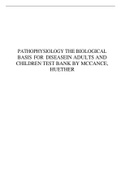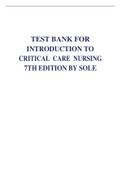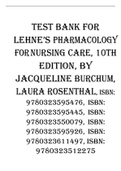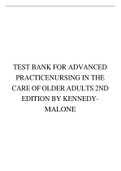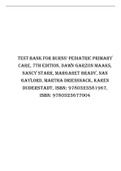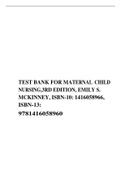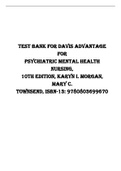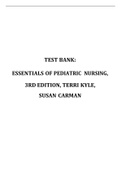Duke University School Of Medicine
Latest uploads at Duke University School Of Medicine. Looking for notes at Duke University School Of Medicine? We have lots of notes, study guides and study notes available for your school.
-
496
- 0
-
6
All courses for Duke University School Of Medicine
- Assessment of Visual and Auditory Systems Lewis: Medical-Surgical Nursing, 10th Edition 1
- ATI Maternal Newborn & Peds 1
- ATI Maternal Newborn Practice B 1
- ATI Maternal Newborn Proctored Exam 2020 / 2021 1
- ATI Maternal Newborn- Practice 2019 B 1
- ATI Med-Surg part A 1
- ATI PHARMACOLOGY ASSESSMENT 2019 1
- ATI PN MENTAL HEALTH PROCTORED EXAM 1
- ATI Skills module 2.0 Medication Administration 1 Notes 1
- Medical-surgical nursing ,10th Edition : assessment and management of clinical problems 5
- Medical-surgical nursing, 10th Edition : assessment and management of clinical problems 3
- MKT 331 Chapters 1 and 2 Test with answers - Cornell University 1
- MN 566 Week 5 Quiz {2020} - Cornell University 1
- MN 566 Week 7 Quiz {2020} - Cornell University 1
- MN 576 Unit 5 Midterm Exam: Cornell University 1
- MN566 Midterm Quiz {2020} – Cornell University 1
Latest notes & summaries Duke University School Of Medicine
Chapter 1: Cellular Biology MULTIPLE CHOICE 1. Which statement best describes the cellular function of metabolic absorption? a. Cells can produce proteins. c. Cells can take in and use nutrients. b. Cells can secrete digestive enzymes. d. Cells can synthesize fats. ANS: C In metabolic absorption, all cells take in and use nutrients and other substances from their surroundings. The remaining options are not inclusive in their descriptions of cellular metabolic absorption. PTS: 1 REF: Pag...
Table of Contents 1 Chapter 01: Overview of Critical Care Nursing Chapter 02: Patient and Family Response to the Critical Care Experience Chapter 03: Ethical and Legal Issues in Critical Care Nursing Chapter 04: Palliative and End-of-Life Care Chapter 05: Comfort and Sedation Chapter 06: Nutritional Therapy Chapter 07: Dysrhythmia Interpretation and Management Chapter 08: Hemodynamic Monitoring Chapter 09: Ventilatory Assistance Chapter 10: Rapid Response Teams and Code Management Ch...
Table of Contents 1 Chapter 01: Overview of Critical Care Nursing Chapter 02: Patient and Family Response to the Critical Care Experience Chapter 03: Ethical and Legal Issues in Critical Care Nursing Chapter 04: Palliative and End-of-Life Care Chapter 05: Comfort and Sedation Chapter 06: Nutritional Therapy Chapter 07: Dysrhythmia Interpretation and Management Chapter 08: Hemodynamic Monitoring Chapter 09: Ventilatory Assistance Chapter 10: Rapid Response Teams and Code Management Ch...
TABLE OF CONTENTS UNIT I: INTRODUCTION 1. Orientation to Pharmacology 2. Application of Pharmacology in Nursing Practice 3. Drug Regulation, Development, Names, and Information UNIT II: BASIC PRINCIPLES OF PHARMACOLOGY 4. Pharmacokinetics 5. Pharmacodynamics 6. Drug Interactions 7. Adverse Drug Reactions and Medication Errors 8. Individual Variation in Drug Responses UNIT III: DRUG THERAPY ACROSS THE LIFE SPAN 9. Drug Therapy During Pregnancy and Breast-Feeding 10. Drug Therapy in P...
Advanced Practice Nursing in the Care of Older Adults / Edition 2 TESTBANK Chapter 1. Changes With Aging Multiple Choice Identify the choice that best completes the statement or answers the question. 1. The major impact of the physiological changes that occur with aging is: A. Reduced physiological reserve B. Reduced homeostatic mechanisms C. Impaired immunological response D. All of the above 2. The strongest evidence regarding normal physiological aging is available through: A. Rand...
Bates’ Guide to Physical Examination and History Taking, 12th Edition Chapter 1: Overview: Physical Examination and History Taking Multiple Choice 1. For which of the following patients would a comprehensive health history be appropriate? A) A new patient with the chief complaint of ―I sprained my ankle‖ B) An established patient with the chief complaint of ―I have an upper respiratory infection‖ C) A new patient with the chief complaint of “I am here to establish care” D) A...
TABLE OF CONTENTS Unit I: Influences on Child Health and Child Health Assessment 1. Health Status of Children: Global and National Perspectives 2. Unique Issues in Pediatrics 3. Genetics and Child Health 4. Environmental Issues 5. Child and Family Health Assessment 6. Cultural Considerations for Pediatric Primary Care 7. Children with Special Health Care Needs Unit II: Child Development 8. Developmental Management in Pediatric Primary Care 9. Developmental Management of Newborns 10. ...
TABLE OF CONTENTS Introduction To Maternal-Child Health Nursing 1 Foundations of Maternity and Child Health Nursing 2 The Nurse's Role in Maternity and Pediatric Nursing 3 The Childbearing and Child-Rearing Family 4 Health Promotion for the Developing Child 5 Health Promotion for the Infant 6 Health Promotion During Early Childhood 7 Health Promotion for the School-Age Child 8 Health Promotion for the Adolescent 9 Heredity and Environmental Influences on Development Maternity Nursing...
Table of Contents I. BASIC CONCEPTS IN PSYCHIATRIC-MENTAL HEALTH NURSING 1. The Concept of Stress Adaptation 2. Mental Health and Mental Illness: Historical and Theoretical Concepts II. FOUNDATIONS FOR PSYCHIATRIC-MENTAL HEALTH NURSING 3. Concepts of Psychobiology 4. Psychopharmacology 5. Ethical and Legal Issues III. THERAPEUTIC APPROACHES IN PSYCHIATRIC NURSING CARE 6. Relationship Development 7. Therapeutic Communication 8. The Nursing Process in Psychiatric-Mental Health Nursing ...
ESSENTIALS OF PEDIATRIC NURSING 3RD EDITION BY KYLE AND CARMAN TEST BANK CHAPTER: INTRODUCTION TO CHILD HEALTH AND PEDIATRIC NURSING Origin: Chapter 1, 1 1. The nurse providing family-centered care in a hospital setting reflects on the focus of the health care provided in today's society. Which statement best describes the current definition of health? A) Health is described as 'an absence of disease.' B) Health is measured by monitoring mortality and morbidity of a group. C) Health ...

